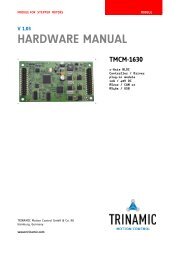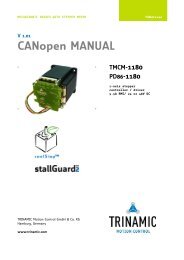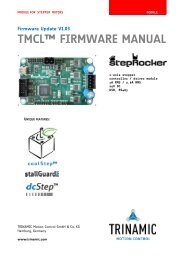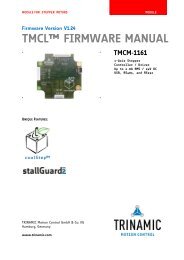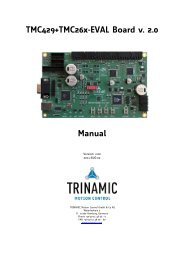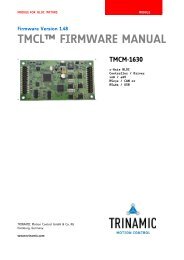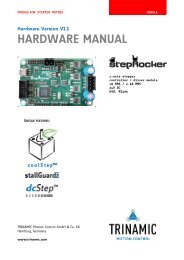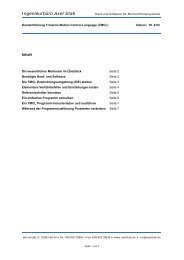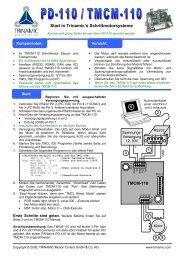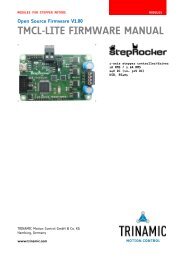TMC428 – Application Note - Trinamic
TMC428 – Application Note - Trinamic
TMC428 – Application Note - Trinamic
You also want an ePaper? Increase the reach of your titles
YUMPU automatically turns print PDFs into web optimized ePapers that Google loves.
<strong>TMC428</strong> <strong>–</strong> <strong>Application</strong> <strong>Note</strong> <strong>–</strong> <strong>TMC428</strong> Getting Started <strong>–</strong> Including StallGuard TM 8<br />
(v. 2.00 / April 14, 2008)<br />
2.2.2 Set the Reference Switch Configuration and the Ramp Mode<br />
Both, the reference switch configuration and the ramp mode are configured by access to a single<br />
register. Normally, this kind of initialization is done once. The switch configuration ref_conf together<br />
with the ramp mode rm has to be chosen. Unused reference switch inputs REF1, REF2, REF3 should<br />
be pulled down to ground or disabled by setting ref_conf. Otherwise, the REF1, REEF2, REF3 inputs<br />
might detect a switch signal and stop a motor.<br />
2.2.3 Set the Automatic Current Scaling [optional]<br />
With the power-on reset settings, the full current is driven when the motor is at rest, during<br />
acceleration, and during motion. Automatic down scaling when the motor is at rest reduces power<br />
dissipation. This makes sense if the application allows lower holding torque for a motor at rest.<br />
For automatic current scaling, it is necessary to switch on the continuous_update, to force the<br />
<strong>TMC428</strong> to send the current scaling datagram, even if all motors are at rest. That does not cause the<br />
<strong>TMC428</strong> to sent datagrams to the stepper motor driver chain.<br />
2.4 Running a Motor<br />
With all these setting described before, one can simply run a stepper motor. In RAMP_MODE, one just<br />
has to write the desired target position into the register x_target of the associated motor. In<br />
VELOCITY_MODE, one just has to write the desired target velocity v_target of the associated motor.<br />
3<br />
1<br />
RRS<br />
3<br />
0<br />
2<br />
9<br />
2<br />
8<br />
2<br />
7<br />
ADDRESS<br />
2<br />
6<br />
2<br />
5<br />
Register is_agtat & is_aleat & is_v0 IDX=%1000 (one for each motor)<br />
2<br />
4<br />
RW<br />
2<br />
3<br />
2<br />
2<br />
2<br />
1<br />
Copyright © 2005-2008 TRINAMIC Motion Control GmbH & Co. KG<br />
2<br />
0<br />
1<br />
9<br />
1<br />
8<br />
1<br />
7<br />
1<br />
6<br />
1<br />
5<br />
1<br />
4<br />
1<br />
3<br />
1<br />
2<br />
1<br />
1<br />
DATA<br />
1<br />
0<br />
9 8 7 6 5 4 3 2 1 0<br />
smda 1 0 0 0 is_agtat is_aleat is_v0 a_threshold<br />
0 0 0 1 0 0 0 0 0 0 0 0 0 0 0 0 0 0 0 1 0 0 0 0 0 0 0 0 0 0 0 0<br />
1 0 0 0 1 0 0 0<br />
Figure 4 : Automatic Current Scaling for a Stepper Motor



